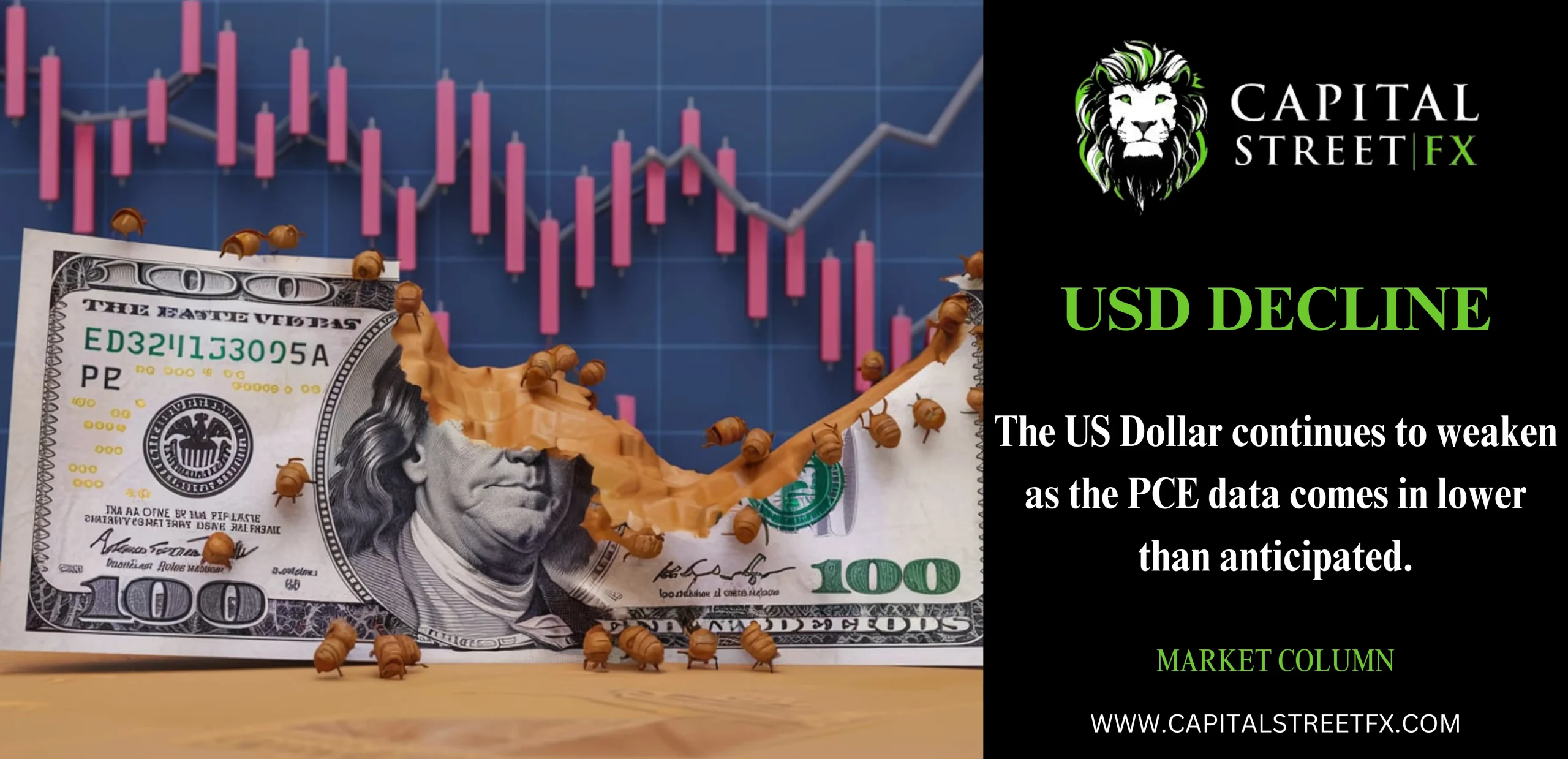The US Dollar continues to weaken as the PCE data comes in lower than anticipated.
US Dollar Declines After Weaker PCE Data: Markets Brace for Rate Cut
The US Dollar has been facing continued pressure as recent data on Personal Consumption Expenditures (PCE) comes in lower than expected. This significant drop in the value of the Greenback follows expectations of further interest rate cuts from the Federal Reserve.
Weaker PCE Data Pushes US Dollar Downward
The US Dollar took a sharp dive after the release of the latest PCE data, a key inflation metric that showed slower growth than anticipated. Market analysts are now expecting the Federal Reserve to implement another rate cut of 50 basis points. This has resulted in the US Dollar Index (DXY) breaking out of its September trading range, signaling growing volatility in currency markets.
The lower-than-expected PCE data has driven these movements, reflecting weakened consumer spending and a softer inflationary environment. As a result, the USD has been losing ground against major currencies, with the likelihood of larger cuts shortly looming.
Read More – Daily Technical Analysis
Rate Cut Expectations and the Impact on the USD
The Federal Reserve has signaled a data-dependent approach to future interest rate decisions. The latest PCE report, which showed a decline in core inflation, has raised market expectations for additional rate cuts. Futures markets now indicate a stronger possibility that the Fed will cut rates by 50 basis points, with the potential for even more aggressive cuts in the months to come.
This anticipation is weighing heavily on the USD. A rate cut would make the US Dollar less attractive to investors seeking higher yields, driving its value down in global currency markets.
DXY Breaks Out of September Range
The US Dollar Index (DXY), a key measure of the Greenback’s performance against a basket of other major currencies, has broken out of its narrow September trading range. This breakout signals heightened volatility and suggests that traders are preparing for significant moves in the currency market, particularly as expectations for more aggressive monetary easing grow.
The DXY’s movement reflects broader uncertainty around the Federal Reserve’s next steps. With inflation coming in lower than expected, the central bank’s November decision will likely be influenced by upcoming economic data, adding to the USD’s volatility.
Read More – Latest Market Outlook Insights
University of Michigan Consumer Sentiment Report Adds to Market Jitters
In addition to the weaker PCE data, the University of Michigan Consumer Sentiment report is expected to further influence market trends. This report, which gauges consumer confidence and spending patterns, could add more pressure on the US Dollar if it reveals softer sentiment or reduced economic activity.
The combination of a lower inflation reading and weaker consumer sentiment could lead to a further decline in the USD. As the Federal Reserve remains highly dependent on economic data to guide its decisions, the release of this report will be closely watched by both policymakers and investors.
US 10-Year Benchmark Yield Drops
The US 10-year Treasury yield, a benchmark for global interest rates, also fell in response to the PCE data, dropping to 3.75%. This decline mirrors the weakening inflationary environment and signals that investors are bracing for lower interest rates shortly.
As bond yields fall, so does the appeal of the US Dollar to international investors, leading to a further drop in the currency’s value. Lower yields tend to reduce foreign demand for US bonds, putting additional downward pressure on the USD.
Future Outlook for the US Dollar
Looking ahead, the US Dollar is expected to remain sensitive to upcoming economic data. The Federal Reserve’s decision in November will largely hinge on how key economic indicators evolve in the coming weeks. If inflation continues to cool and consumer sentiment weakens further, the likelihood of more aggressive rate cuts will grow, pushing the US Dollar even lower.
Markets are closely watching how the Fed responds to these developments. As the central bank takes a more cautious approach, the Greenback’s future is likely to remain uncertain, with the potential for further downside risk depending on the outcome of upcoming reports and data releases.
Read More – Daily Trading Articles And Updates
Conclusion
The US Dollar is facing increasing headwinds as weaker-than-expected PCE data has fueled speculation of further interest rate cuts by the Federal Reserve. With the DXY breaking out of its September range and bond yields declining, the outlook for the USD remains bearish in the short term. Investors will be paying close attention to upcoming data, including the University of Michigan Consumer Sentiment report, as the Fed’s November decision approaches.
In the meantime, the US Dollar is expected to continue facing downward pressure, especially as markets brace for the possibility of even larger rate cuts in the future.

